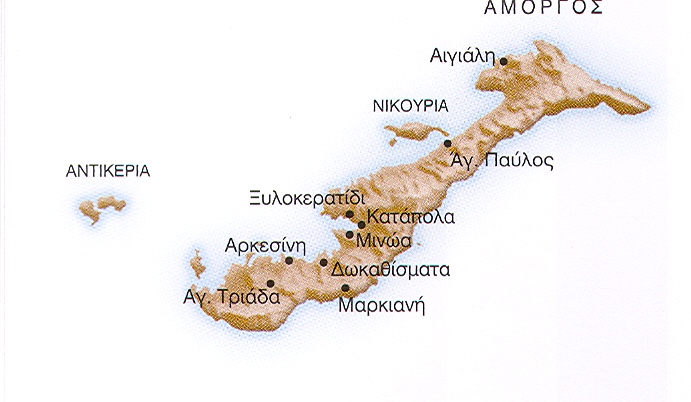AMORGOS
The Easternmost Cycladic island hosted no less than three cities in classical times. The oldest archaeological site dates back to the late 5th millennium, during the Late Neolithic and was located on the site of the future Minoa. Amorgos was one of the most important islands during the Early Cycladic period (third millennium BC). From this period numerous cemeteries came to light (Dokathismata, Kapsala, Kapros Stavros, Ag. Paraskevi, Ag. Pavlos, Nikouria etc.) but also the a fortified acropolis at Makryani. In the Middle Bronze Age evidence are quiet rare and next remains of particular interest date from the Late Bronze Age. In the bay of Katapola were found several chamber tombs of the thirteenth and twelfth centuries and the data suggest that the Mycenaean settlement should be nearby.
In the historical period the importance of the island grows with the foundation of three cities.
Aigiale was founded by the Milesians. The discovery of some archaic gravestones confirms the literary sources. Despite the lack of systematic research, one can see inside the city wall a number of ancient ruins. Moreover inscriptions make specific mention of public buildings but also of shrines and sanctuaries. There are among others those of Zeus Polieus and Athena Polias, Hera, Apollo, Poseidon, Eileithyia, the Mother of the Gods, Tyche, Isis and Serapis.
Minoa was supposedly founded in the seventh century by the Samians on the remains of a prehistoric settlement. Archaeological excavations conducted by L. Marangou testify an uninterrupted occupation from the eleventh century BC to the third century AD. There are no clear traces of the settlement of the EIA. On the other hand significant evidence for the early occupation of the site derives from the a funerary peribolos and a place of worship nearby associated with a pit full with ashes, marked by peribolos (with its foundation sacrifice in situ). The city was fortified during the Geometric period and an important sanctuary of the eighth century was established on the summit of the acropolis at the same time. The classical period is mostly marked by renovations of the defensive installations, while during the Hellenistic period several buildings were erected, including the “marble temple” at the Lower Town. The cult on the Acropolis was at that time dedicated to Dionysus, who was worshipped there untill the Roman era. Inscriptions attest the existence of a number of sanctuaries sanctuaries but none of them has been found yet. In the lower part of the city, at the port of Minoa (Katapola) there existed a sanctuary dedicated to Apollo Pythios.
The final publication of Minoa on Amorgos by Lila Marangou constitutes an up to date acute synthesis of the research conducted for more than two decades at one of the tree poleis of the island and its urban sanctuaries and cult places (L. Marangou, Αμοργός Ι: η Μινώα: η πόλις, ο λιμήν και η μείζων περιφέρεια, Athens 2002).
Arkesine was the third and most western of the cities of Amorgos. According to the literal tradition it was founded by Naxians in the archaic period. The site has not been excavated yet but one can clearly distinguish the walls of the city. The ancient inscriptions are of great help for reconstructing the religious landscape and attedt the existence of sanctuaries of Delian Apollo, Hera, Artemis, Aphrodite Ourania on the Aspis, Demeter, Zeus Apotropaios, Eileithya and Dionysos. One may also mention the extra-urban sanctuary to Athena Itônia.
BIBLIOGRAPHY
Blanas, A. 2006. Geometrische Keramik aus Minoa auf Amorgos, Münster.
Boussac, M. F. & G. Rougemont. 1983. Observations sur le territoire des cités d'Amorgos Les Cyclades. Matériaux pour une étude de géographie historique. Table ronde réunie à l'Université de Dijon, les 11, 12 et 13 mars 1982, 197.
Catling, R. W. V. & R. E. Jones. 1989. Protogeometric vases from Amorgos in the museum of the British School, BSA 84: 177-185.
Marangou, L. 1982. Reliefkeramik aus Amorgos, Freytag, B. v., D. Mannsperger & F. Prayon (eds), Praestant interna. Festschrift für Ulrich Hausmann, 190-198.
Marangou, L. 1996. Minoa Nell'età geometrica, Lanzillotta, E. & D. Schilardi (eds), Le Cicladi ed il Mondo Egeo, Roma 19-21 novembre 1992, 187-209.
Marangou, L. 1998. The acropolis sanctuary of Minoa on Amorgos: cult practice from the 8th century BC to the 3rd century AD, Hägg, R. (ed.) Ancient Greek Cult Practice from the Archaeological Evidence. Proceedings of the Fourth International Seminar on Ancient Greek Cult, organized by the Swedish Institute at Athens, 22-24 October 1993.
Marangou, L. 2002. Αμοργός Ι - Η Μινώα : Η πόλις, ο λιμήν και η μείζον περιφέρεια, Athènes.
Marangou, L. 2006. Céramique attique à Amorgos : données archéologiques et tradition littéraire, La Genière, J. d. (ed.) Les clients de la céramique grecque, Paris, 69-74.
Pappa, V. 1994. Eρυθρoβαφές αγγείo με ανάγλυφη διακóσμηση απó τη Mινώα Aμoργoύ Φηγός. Tιμητικóς τóμoς για τoν καθηγητή Σωτήρη Δάκαρη, 423-433.


